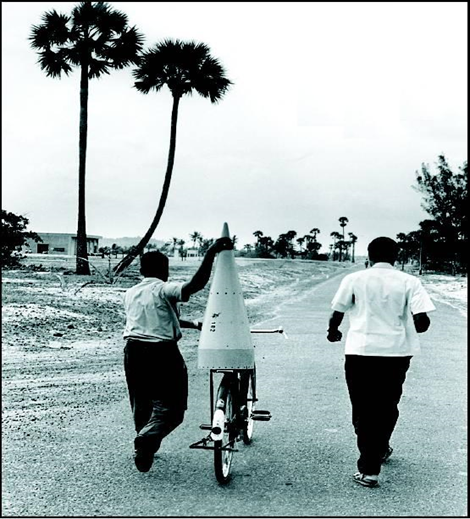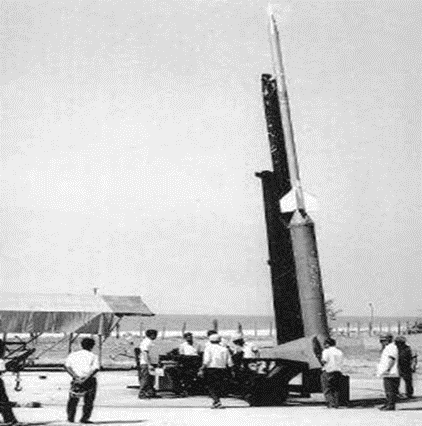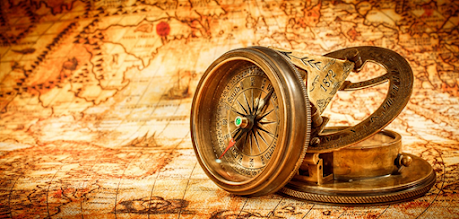INDIA’S SPACE ODYSSEY
ON 26th of March 2023 INDIAN SPACE RESEARCH ORGANISATION’s (ISRO) LVM3 M3/ OneWeb India-2 Mission was accomplished successfully. In its sixth consecutive successful flight of LVM3, the vehicle placed 36 satellites belonging to the OneWeb Group Company in their intended 450 km circular orbit with an inclination of 87.4 degrees. The vehicle took off with a total payload of 5,805 kg at 09:00:20 hours IST from the second launch pad at SDSC-SHAR, Sriharikota.
But was it so effortless for always? Was this the condition of ISRO in the 20th century or during its initial period in the 1960s? Let us find out more about how India at first place began its walk towards space and soon became a part of the space race along with the USSR and USA.
On November 21,1963, a small rocket took off from Thumba on the outskirts of Thiruvananthapuram, announcing the birth of the modern space age in India. This is the interesting story of Indian space history's first milestone.
When Prime Minister Indira Gandhi asked Rakesh Sharma (India’s first astronaut) how their country looked from space, he famously replied, “Saare jahan se achcha.”
So, the story begins in Thumba, till 1963, the obscure village of Thumba would not have merited a second look. A quintessential Kerala fishing hamlet with thatched huts, coconut groves and a peaceful sea, it was an unlikely setting for a rocket launch station. However, it did have something that caught the interest of Dr Vikram Sarabhai, the father of India’s space programme. A small church dedicated to St Mary Magdalene was located on the Earth's magnetic equator.
So, one fine day, Dr Sarabhai, and his fellow scientists (including Dr APJ Abdul Kalam) went to Thumba to talk to the then-bishop of Trivandrum who lived in the house adjacent to the church. They were interested in acquiring the church and the nearby land for their first rocket launch. Instead of giving them a definite answer, the bishop asked them to attend the Sunday mass that week, where he would put the question to the parishioners.
At the mass, the bishop explained the scientific mission and asked the permission of his congregation to hand over the church to the scientists. Thanks to the bishop’s efforts, permission was granted. The bishop’s home was quickly converted into an office, the church became the workshop, and cattle sheds served as storage houses and laboratories. Undeterred by the little funding and few facilities, a handful of enthusiastic young Indian scientists began assembling their first rocket.
Carefully selected by Dr Sarabhai, the then-chairman of the national committee on space research, these young scientists and engineers had been trained in sounding rocket assembly and launching at NASA’s Wallops Island launching facility in Virginia, United States. The early recruits included former President Dr APJ Abdul Kalam and veteran scientist R Aravamudan.
Back then, even rocket parts and payloads were transported by bullock carts and bicycles to the launch pad. It was in these unassuming settings that India staged its first launch—that of a Nike-Apache rocket supplied by NASA.
After six months of labour, on 21 November 1963, India was ready for its very first rocket launch. Many eminent names in science and technology gathered for the occasion, including Dr Homi Bhabha (the father of the Indian nuclear programme) and Dr P R Pirashoty (the founder-director of the Indian Institute of Tropical Meteorology).
When the rocket was rolled out onto the launch pad, the sultry air was thick with tension. And almost immediately things started going awry. As the rocket was being hoisted onto the launcher, the hydraulic crane developed a leak. Somehow, it was manually shifted into position. Next, the remote system of the launcher malfunctioned. Once this was fixed, things finally seemed in order. As the alarm sounded to clear the area around the launch pad, the team of scientists held their breath.
At 6.25 pm, the world was watching as the rocket streaked away into the gathering dusk. Minutes later, a sodium vapour cloud had emerged in the sky high above, tinted orange by the setting sun. India had successfully put its first signature on space.
Sixty years later, Thumba is the hub of all space programmes helmed by the Indian Space Research Organisation (ISRO). The Vikram Sarabhai Space Centre at Thumba has given India launch vehicles, geostationary satellites (used for telecommunications, television transmission and weather forecasting) and some of the finest remote sensing satellites.
As for the little church that helped India reach for the stars, it now houses a space museum replete with a fascinating array of rockets, satellites, and other astronomical equipment. If today India is a self-reliant and world-class space-faring nation, there are many to thank from that first launch at Thumba: the USA, for the two-stage Nike Apache rocket; France, for the sodium vapour payload; the Soviet Union, whose Mi-4 helicopter gave the range clearance; and, of course, ISRO’s rocket and payload engineers.
Within four years India built its own rocket from the experience it gathered in Thumba. The RH-75 was India's first indigenous rocket which was launched in 1967 and by 1975, India had built its own satellite named Aryabhata after the Indian astronomer and launched it from Russia. In Bangalore, a toilet was converted into the satellite's data receiving centre. Indians came together to celebrate Aryabhata.
The satellite's photo was printed on Indian currencies between 1976 and 1997 as Aryabhata made ISRO a household name. ISRO started in 1962 and was named the Indian national committee for space research, however, in 1969 it was renamed Indian Space Research Organisation (ISRO).
https://akm-img-a in.tosshub.com/businesstoday/images/story/201601/isro_660_040514032543_010516123143.jpg
The struggle was real, and it was not easy to achieve what we currently have without the hard work and determination of people like Dr Sarabhai, Dr Abdul kalam and many more. At any point in this tiring, nobody gave and the small contributions of everyone really bloomed well as a result today India not only competes with nations like Russia, the USA, Japan, UK but is one of the leading, most efficient, and most promising space programmes which is all due to our respect for Engineers, scientists and all others who worked really hard in achieving this success.
sources:
1. The Better India
2. Wion news
3. The times of India
NOTE: -
This blog is meant for educational purposes only. The information provided in this article is not investment advice. We do not own any Copyrights related to images and information; all the rights go to their respective owners. The sole purpose of this blog is to Educate, Inspire, Empower and to create awareness in the viewers. The usage is non-commercial (Not for Profit) and we do not make any money from it.
Write your feedback here:
https://forms.gle/C3ybXMPPUaJBgP618
FOLLOW US ON:-
INSTAGRAM:
https://bit.ly/coep_blogs_insta
LINKEDIN:
https://bit.ly/coep_blogs_linkedIn
YOUTUBE:-
https://bit.ly/Coep_blogs_YouTube















Comments
Post a Comment